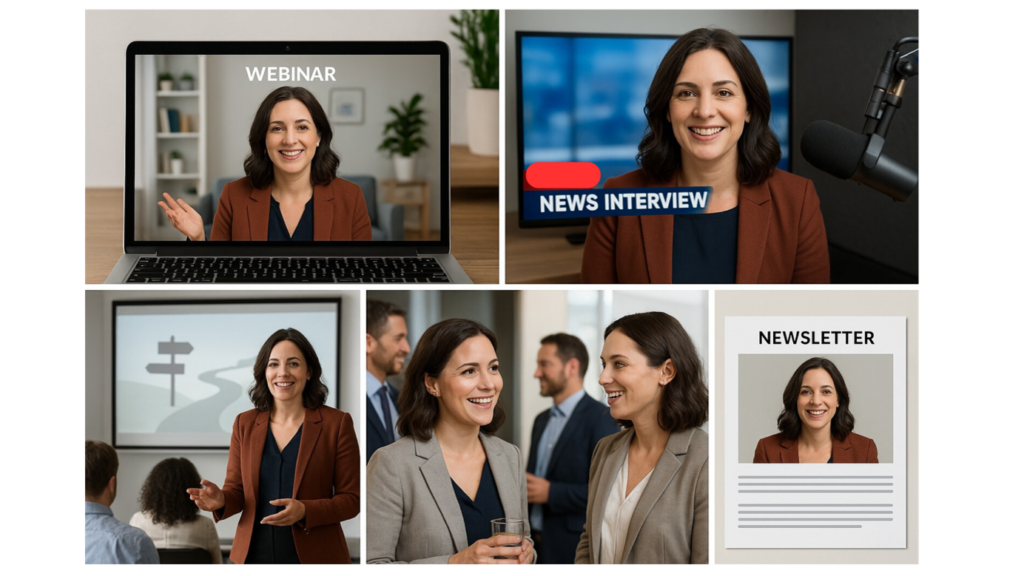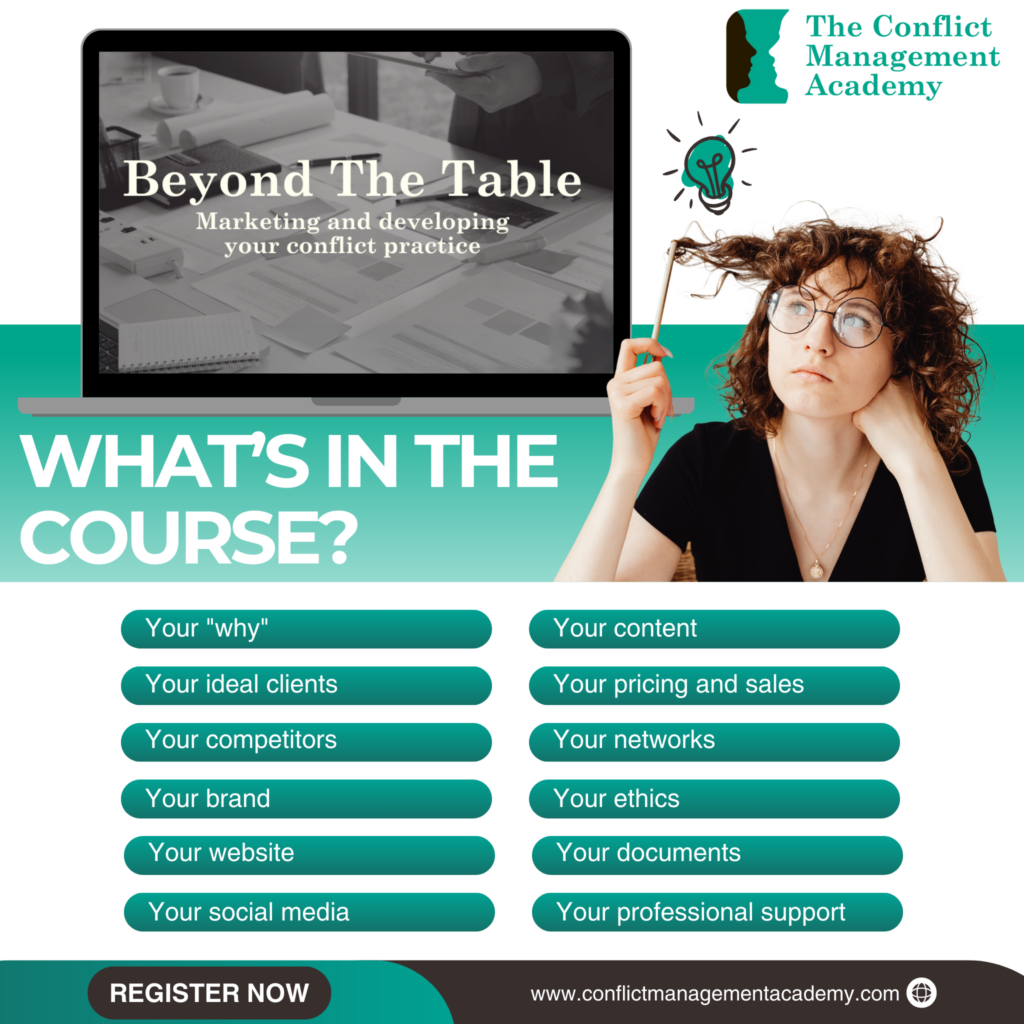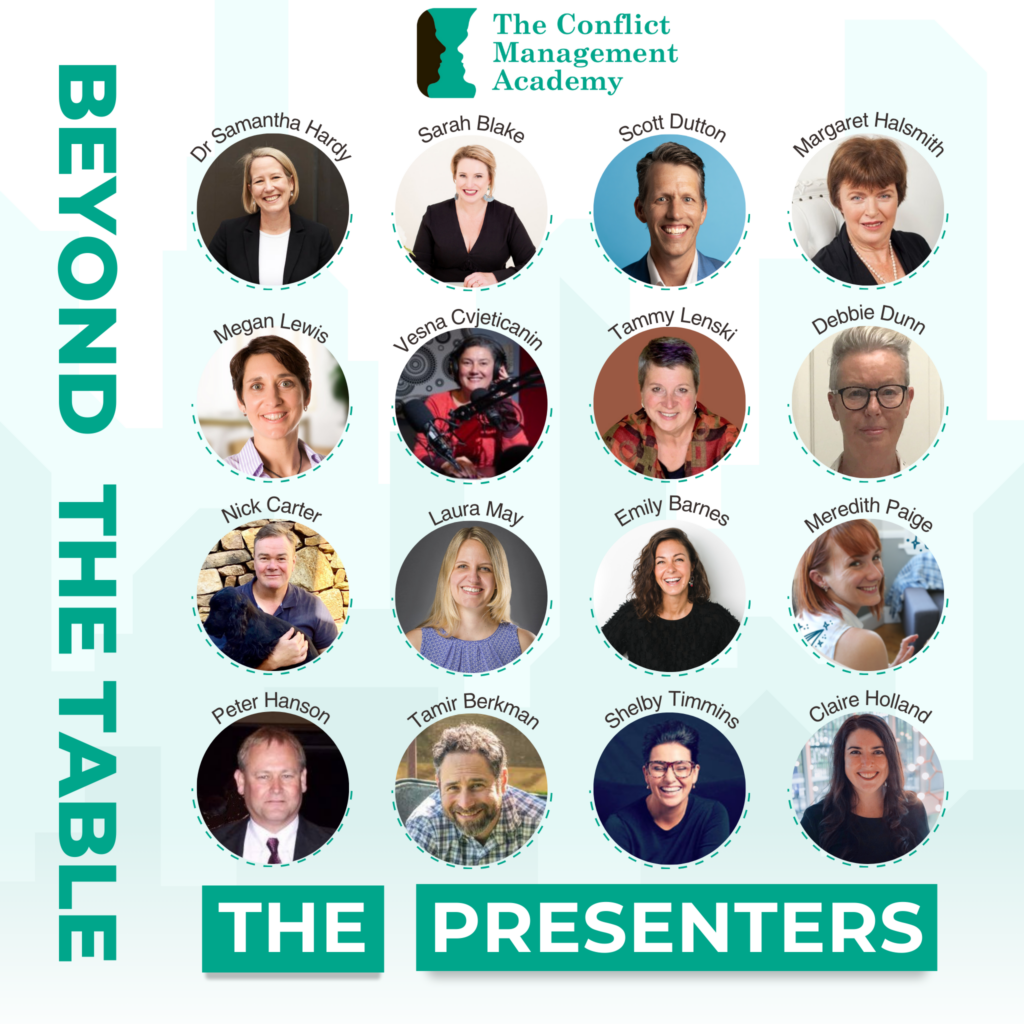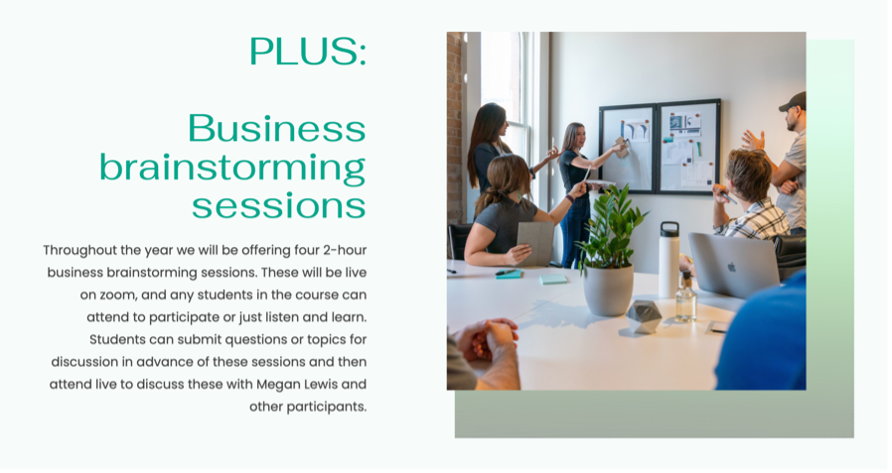The Conflict Management Academy offers regular Business Brainstorming Sessions as an accompaniment to our Beyond the Table course. These sessions are facilitated by experienced mediator and successful business owner Megan Lewis. Here are some of the key insights and tips shared in the last session.
Building a successful mediation practice takes more than just excellent conflict resolution skills. For many practitioners, especially those transitioning into private practice, the greatest challenges lie not in the mediation room, but in the work of attracting, converting, and retaining clients.
In a recent business brainstorming session mediators at different stages of their business journey gathered to exchange ideas, ask questions, and offer peer support. From early career mediators still finding their feet to established practitioners looking to grow, the conversation covered marketing strategies, website effectiveness, referral networks, branding, and the emotional challenge of “selling” oneself in a values-driven profession.
Here are some of the most valuable tips, reflections, and lessons shared in that conversation.

1. Know Why You’re Doing This
Before focusing on growth strategies, Megan emphasized the importance of starting with a clear “why.”
Why are you in this work? What kind of practice do you want to build? Who do you want to work with—and how do you want to spend your days?
Defining your purpose helps create a practice that is sustainable and aligned with your values. It also influences how you present yourself to the world, the services you offer, and the tone of your marketing. For example, Megan’s private practice—focused on workplace mediation—has a mission to “support business owners to make and implement the best decisions for their business and their team.” That clarity helps guide service design, branding, and referral relationships.

2. Understand Your Client: The Power of Focus
One of the recurring themes in the discussion was the need to define your audience. Rather than trying to serve “anyone with a conflict,” mediators were encouraged to:
Identify the types of clients they most enjoy working with
Understand their clients’ needs, pain points, and language
Tailor services and marketing messages accordingly
For example, a mediator working with small business owners may need different messaging than one working with separating parents. As Megan put it: “It’s the same face, but a different audience.” Without clarity on who your services are for, it’s difficult to know how—and where—to market effectively.

3. Marketing Is a Skill—And One You Can Learn
Marketing was a major focus of the session. While many mediators feel uncomfortable with self-promotion, the group reinforced that marketing is not about exaggeration or manipulation. It’s about:
Explaining clearly how you help
Making it easy for people to understand what to do next
Building trust over time
Practical marketing tips discussed included:
Track your enquiries: Know where clients are coming from and which marketing activities are converting.
Use client-centred language: Speak to the client’s problem, not your qualifications.
Position yourself as the guide, not the hero: Let the client be the main character in the story. Your role is to support their transformation.
One book recommendation that resonated with the group was Building a StoryBrand by Donald Miller, which outlines how to craft marketing messages that centre on the client’s journey.

4. Don’t Just Build a Website—Build a Client Journey
Several participants discussed their websites as a primary channel for enquiries—but results varied significantly. A family mediator on the Gold Coast, reported consistent leads through her website, while a regional mediator with an active Facebook community, saw far fewer.
The difference, Megan suggested, often lies in the structure and strategy behind the website.
Key tips for website effectiveness:
Call-to-action buttons should be clear, visible, and action-oriented. Avoid vague prompts like “learn more”; instead use phrases like “Book a consultation” or “Start your resolution journey.”
Client pathways should be easy to navigate. What does the visitor see when they land? Can they immediately find out if you’re the right fit and how to proceed?
Search engine optimisation (SEO) matters. If you’ve built your website yourself, make sure it’s optimised so it shows up in relevant search results.
Testimonials and credentials build credibility and trust.
Even for those not naturally tech-savvy, a professionally built, strategically written website can make a significant difference.

5. Use Multiple Channels for Visibility
A consistent message throughout the session was that visibility precedes credibility, which precedes profitability.
Clients can’t hire you if they don’t know you exist. And they won’t trust you if they’ve only seen your name once.
Tactics discussed for building visibility included:
Speaking at local business chambers or professional events
Attending networking groups (like BNI)
Connecting with local counsellors, psychologists, and accountants
Running webinars or Q&A sessions for potential clients
Creating email newsletters and social media content

6. Referrals Take Time—and Strategy
Many mediators in the session expressed frustration with the lack of responsiveness from law firms and other professionals they had approached for referrals. Megan reminded the group that referral networks are relationship-based, not transactional. A single flyer or email is unlikely to generate results.
Instead, she suggested:
Demonstrating professionalism through visibility (e.g., ads, presentations, public events)
Offering value to potential referrers (e.g., helpful content, tools for clients)
Being specific: How can they refer? When should they? What is in it for them?
Considering alternative referrers: child care centres, financial planners, GPs, and community groups often witness conflict first-hand
Ultimately, the goal is to make the referrer’s job easier. Don’t just market to potential clients—market to your referral sources too.

7. Selling Yourself Without Feeling Salesy
One of the most vulnerable parts of the session came when mediators admitted how difficult they found it to talk about themselves. When clients ask, “Why should I choose you?”, the instinct is often to deflect or downplay.
One mediator shared that her standard response has been to invite clients to shop around, encouraging them to find the mediator who feels like the right fit. While this approach reflects humility and client-centeredness, it can also lead to lost conversions.
Tips for more confident self-presentation:
Frame your credentials as part of your origin story. For example, perhaps you left legal practice because you saw the harm it caused to families—now you work to prevent that harm.
Focus on the value you offer, not just your background.
Practice a concise, values-aligned response to “Why you?” so you can answer with clarity and confidence when the question comes.
Megan encouraged mediators to avoid the extremes of under-selling or over-selling. The goal is to speak truthfully and compellingly about the help you provide.

8. Play the Long Game—and Track What Works
Perhaps the most important insight from the session was that building a mediation practice takes time. One to two years is a realistic timeframe for most mediators to begin building momentum—especially if they are starting from scratch.
In the meantime, it’s vital to:
Track your progress: enquiries, conversions, repeat clients
Test and refine your strategies
Stay connected to professional peers
Protect your energy and avoid burnout by focusing on aligned work
Megan closed the session by reinforcing the need to design a business that sustains you over time—personally and professionally.
Final Thoughts
The business of mediation is not simply about being a good mediator. It’s about being a clear communicator, a thoughtful business owner, and a trusted presence in your community or sector.
If you’re struggling to find your footing or looking to grow your practice, the message from this session is clear: You are not alone. Every successful mediator has walked the same uncertain path—and there are many tools, insights, and strategies available to help you shape the practice you want to have.
Start with your why, know your clients, be consistent in your messaging, and above all, keep going.


To find out more about our Beyond the Table course, click here: https://conflictmanagementacademy.com/btt

The next Business Brainstorming Session is coming up on 22 April. To join us, click here: https://conflictmanagementacademy.com/btt-business-brainstorming-sessions/

